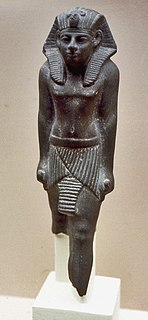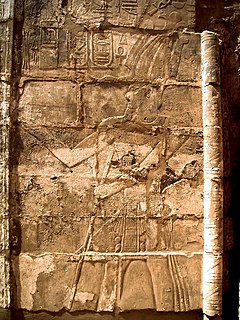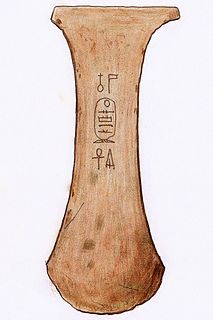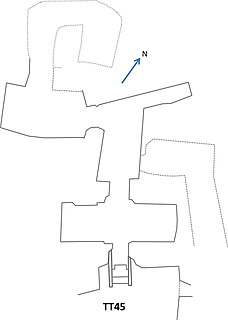See also
- Jehuty, a fictional entity in the Zone of the Enders game
- Zehuti (Thoth), one of the gods from whom Black Adam, a DC Comics villain, derives his powers
Djehuty is another name for Thoth, an ancient Egyptian god.
Djehuty or Djehuti is also the given name of:

Thoth is an ancient Egyptian deity. In art, he was often depicted as a man with the head of an ibis or a baboon, animals sacred to him. His feminine counterpart was Seshat, and his wife was Ma'at. He was the god of wisdom, writing, hieroglyphs, science, magic, art, judgment, and the dead. His Greek equivalent is Hermes.
Iah is a lunar deity in ancient Egyptian religion. The word jˁḥ simply means "Moon". It is also transcribed as Yah, Yah(w), Jah, or Aah.
Thutmose is an Anglicization of the Egyptian name dhwty-ms, usually translated as "Born of the god Thoth". It may refer to several individuals from the 18th Dynasty:

Manetho is believed to have been an Egyptian priest from Sebennytos who lived in the Ptolemaic Kingdom in the early third century BC, during the Hellenistic period. He authored the Aegyptiaca in Greek, a major chronological source for the reigns of the kings of ancient Egypt. It is unclear if he wrote his history and king list during the reign of Ptolemy I Soter or Ptolemy II Philadelphos, but no later than that of Ptolemy III Euergetes.

Merankhre Mentuhotep VI was a Theban king of the Sixteenth Dynasty of Egypt based in Upper Egypt during the Second Intermediate Period. He was perhaps the 14th king of the dynasty.
Amenemḥat or Amenemhēt, hellenized as Ammenémēs or as Ammanémēs, is an Ancient Egyptian name meaning "Amun is in front". Amenemhat was the name of a number of kings, princes and administration officials throughout ancient Egyptian history.

Usimare Setepenamun Takelot III Si-Ese was Osorkon III's eldest son and successor. Takelot III ruled the first five years of his reign in a coregency with his father, according to the evidence from Nile Quay Text No.13, and succeeded his father as king the following year. He served previously as the High Priest of Amun at Thebes. He was previously thought to have ruled Egypt for only 7 years until his 13th Year was found on a stela from Ahmeida in the Dakhla Oasis in 2005.

Sewadjare Mentuhotep is a poorly attested Egyptian pharaoh of the late 13th Dynasty, who reigned for a short time c. 1655 BC during the Second Intermediate Period. The Egyptologists Kim Ryholt and Darrell Baker respectively believe that he was the fiftieth and forty-ninth king of the dynasty, thereby making him Mentuhotep V. Thus, Sewadjare Mentuhotep most likely reigned shortly before the arrival of Hyksos over the Memphite region and concurrently with the last rulers of the 14th Dynasty.

The Ostracon of Senemut is an ancient Egyptian limestone ostracon. It dates from the reign of Hatshepsut, in the 18th Dynasty.

Semenre, also Smenre or Semenenre, is a poorly attested Theban pharaoh during the Second Intermediate Period of Egypt who succeeded the equally obscure Nebiriau II. He reigned from 1601 to 1600 BC or ca. 1580 BC and belonged to the 16th Dynasty (Ryholt) or the 17th Dynasty (Franke).
"The Taking of Joppa" is an ancient Egyptian tale describing the conquest of the Canaanite town of Yapu (Joppa) by Thutmose III's general Djehuty. The extant copy of the text is on the verso of Papyrus Harris 500.

The Theban Tomb TT11 is located in Dra' Abu el-Naga', part of the Theban Necropolis, on the west bank of the Nile, opposite to Luxor. It is the burial place of the ancient Egyptian Djehuty, who was Overseer of Treasury and of Works, during the 18th Dynasty reign of Hatshepsut.
Amun was a major ancient Egyptian deity who appears as a member of the Hermopolitan Ogdoad. Amun was attested from the Old Kingdom together with his wife Amaunet. With the 11th Dynasty, Amun rose to the position of patron deity of Thebes by replacing Montu.

Djehuty was a general under the ancient Egyptian king Thutmose III in the 18th Dynasty. He is known as the main hero of the tale of "The Taking of Joppa". Djehuty bears the titles king's scribe, overseer of troops (general) and overseer of the northern foreign countries in contemporary Egyptian records.
Khamerernebty I was an ancient Egyptian queen of the 4th dynasty. She was probably a wife of King Khafre and the mother of King Menkaure and Queen Khamerernebty II. It is possible that she was a daughter of Khufu, based on the fact that inscriptions identify her as a King's daughter.

The Theban Tomb TT45 is located in Sheikh Abd el-Qurna, part of the Theban Necropolis, on the west bank of the Nile, opposite modern Luxor. It was originally the burial place of the ancient Egyptian named Djehuty (Thoth), who was a scribe of the offering-table of Mery, high-priest of Amun, head of all the weavers of Amun, and steward of Mery, high priest of Amun. Djehuty lived during the reign of Amenhotep II. He was the son of a lady also named Djehuty.

Sekhemre Sementawy Djehuti was possibly the second king of the Theban 16th Dynasty reigning over parts of Upper Egypt during the Second Intermediate Period. Alternatively, he may be a king of the late 13th Dynasty or the fourth king of the 17th Dynasty. Djehuty is credited with a reign of 3 years in the first entry of the 11th column of the Turin canon. According to Egyptologists Kim Ryholt and Darrell Baker, he was succeeded by Sobekhotep VIII.
Africa is home to a rich embodiment of cultures, and a remarkable cultural history. This is so, in spite of the general unwritten preservation and transmission of African cultures. African cultures celebrate a depth of appreciation of the human experience, and the use of proverbs, dance, folklore, etc. in expressing a profound understanding of reality. Culture represents a society’s response to social changes, and becomes a vehicle for social development. Through culture, epistȇmȇ is harnessed and transformed into technȇ. One of these rich cultural histories in Africa is seen in Egypt.

Sekhemrekhutawy Pantjeny was an Egyptian pharaoh during the Second Intermediate Period. According to the Egyptologists Kim Ryholt and Darrell Baker, he was a king of the Abydos Dynasty, although they leave his position within this dynasty undetermined. Alternatively, Pantjeny could be a king of the late 16th Dynasty. According to Jürgen von Beckerath, Pantjeny is to be identified with Sekhemrekhutawy Khabaw, whom he sees as the third king of the 13th Dynasty.